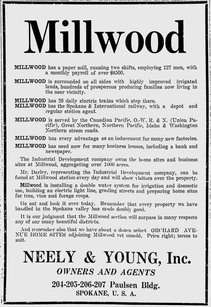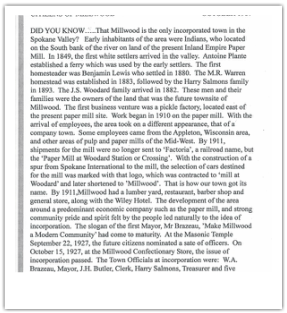
Early Residents
For, centuries the Upper Spokane Indians wintered next to the Spokane River at present day Millwood. They built sweat lodges and dried the salmon they caught from the swift flowing river.
Development
In the decade between 1900 and 1910, the population more than doubled in the rapidly developing city of Spokane Washington. Inevitably the broad fertile Spokane River Valley located east of the city also attracted developers. A newly formed Coeur d’Alene Spokane Railroad Co. planned an electric rail line in 1903. Early settlers Seth Woodard and his father, Joseph Woodard, enticed the company with the promise of free right of way through their land. In gratitude, the railroad company located Woodard Station on the edge of Seth Woodard's land. A north-south road was established through Woodard Station in 1908. The following year a new bridge across the Spokane River connected Woodard Station to the vast agricultural regions to the north. The transportation and river attracted industry in 1909. W.A. Brazeau convinced Nekoosa -Edwards Paper Co. in Appleton, Wisconsin to invest in building a paper mill at Woodard Station. The new mill began producing paper in September 1911.
The town gets started
The mill’s management wanted a town name that would promote the mill. Millwood was chosen as a name that would represent both the mill and the Woodards. Businesses soon located in the fledgling “company town.” in addition to mill employees, they wanted to serve local residents and area farmers. By 1911 Millwood had a lumberyard, restaurant, barbershop, general store and the Wiley Hotel. 1912 brought the Millwood hotel and the first Byram building. Mill workers and their families flooded in from the Midwest. Very little suitable housing existed in the area. In 1923 the paper mill management established a revolving home loan fund to help their employees build their own quality homes. The company offered lots for sale and provided books of house plans for reference. In 1928 the town of Millwood became the first incorporated town in the Spokane Valley.
Millwood Washington
Millwood’s original platted town site showcases homes and commercial buildings of the 1920s and 1930s era. This core neighborhood was listed on the National Historic Register as “Millwood Historic District” in 2001. Grandview Acres (east of the mill) represents the early 1900’s dream of owning a large plot of land, within easy commuting distance to shopping and job-a healthy place to raise both children and food. The increased demand for housing following World War II spurred the annexation and planning of several tracts of land in 1946. These Millwood neighborhoods display an interesting variety of well-kept post WW II ranch style homes. In 2007 Millwood has grown to a population near 1700. Inland Empire Paper Co. continues to produce paper in the center of town. Town residents like their predecessors, cherish the independence and character of their small town. They are also beginning to recognize the importance of their town’s unique history and picturesque historic neighborhoods.
For, centuries the Upper Spokane Indians wintered next to the Spokane River at present day Millwood. They built sweat lodges and dried the salmon they caught from the swift flowing river.
Development
In the decade between 1900 and 1910, the population more than doubled in the rapidly developing city of Spokane Washington. Inevitably the broad fertile Spokane River Valley located east of the city also attracted developers. A newly formed Coeur d’Alene Spokane Railroad Co. planned an electric rail line in 1903. Early settlers Seth Woodard and his father, Joseph Woodard, enticed the company with the promise of free right of way through their land. In gratitude, the railroad company located Woodard Station on the edge of Seth Woodard's land. A north-south road was established through Woodard Station in 1908. The following year a new bridge across the Spokane River connected Woodard Station to the vast agricultural regions to the north. The transportation and river attracted industry in 1909. W.A. Brazeau convinced Nekoosa -Edwards Paper Co. in Appleton, Wisconsin to invest in building a paper mill at Woodard Station. The new mill began producing paper in September 1911.
The town gets started
The mill’s management wanted a town name that would promote the mill. Millwood was chosen as a name that would represent both the mill and the Woodards. Businesses soon located in the fledgling “company town.” in addition to mill employees, they wanted to serve local residents and area farmers. By 1911 Millwood had a lumberyard, restaurant, barbershop, general store and the Wiley Hotel. 1912 brought the Millwood hotel and the first Byram building. Mill workers and their families flooded in from the Midwest. Very little suitable housing existed in the area. In 1923 the paper mill management established a revolving home loan fund to help their employees build their own quality homes. The company offered lots for sale and provided books of house plans for reference. In 1928 the town of Millwood became the first incorporated town in the Spokane Valley.
Millwood Washington
Millwood’s original platted town site showcases homes and commercial buildings of the 1920s and 1930s era. This core neighborhood was listed on the National Historic Register as “Millwood Historic District” in 2001. Grandview Acres (east of the mill) represents the early 1900’s dream of owning a large plot of land, within easy commuting distance to shopping and job-a healthy place to raise both children and food. The increased demand for housing following World War II spurred the annexation and planning of several tracts of land in 1946. These Millwood neighborhoods display an interesting variety of well-kept post WW II ranch style homes. In 2007 Millwood has grown to a population near 1700. Inland Empire Paper Co. continues to produce paper in the center of town. Town residents like their predecessors, cherish the independence and character of their small town. They are also beginning to recognize the importance of their town’s unique history and picturesque historic neighborhoods.
